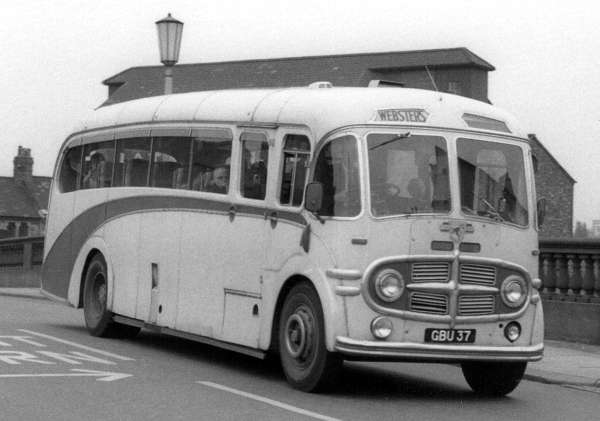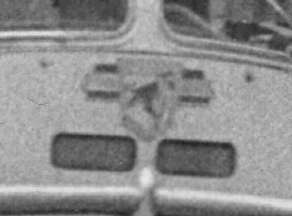Websters GBU 37
Websters GBU 37

Well, all I can say about this is that it has Plaxton bodywork and was registered in Oldham in 1951 as GBU 37. And that's where the questions start! First of all the radiator cowling isn't right for a 1951 Venturer on front engined chassis - this design was first shown at the Commercial Motor Show in October 1952 for delivery in 1953 and continued in production until replaced by the Consort model in 1956. So it looks as if it was modified at some point. Secondly, while the side flash etc screams "Plaxton" at me, it actually screams "late 1940s half-cab Plaxton", and that radiator design was also used by Wilks & Meade of Leeds on various half-cab rebuilds.

Secondly, there's some kind of large badge above the radiator grille, but enlarging it just makes it fuzzier and I don't recognise it from the shape and what is visible. Any ideas?
Thirdly, it carries the word "Websters" in the eyebrow blind. The print it's scanned from was bought at a rally and is a "white back" so no help there. I was hoping it was owned by Webster of Alvanley in Cheshire (for my next book on North West independents) but I don't have any fleet details for them before 1960 so I can't check it that way. Can anyone give me more details?
Neville Mercer
26/06/13 - 15:50
The fact that the company you refer to is Webster (singular) of Alvanley may suggest that this is not one of their vehicles. Another possibility is Websters of Hognaston, Derbyshire. I'm not sure what they operated in this time-frame (other than Bedford OB and OWB) - but it was their practise to use the name Websters (with the 's').
Stephen Ford
26/06/13 - 15:51
The wheel trims and the size of the rear hubs suggest it could be a Leyland, in which case it could be a rebodied Tiger, but the badge is a Royal Tiger. Wishful thinking one someones part perhaps?
Ronnie Hoye
27/06/13 - 06:56
That the photograph was taken in Oldham makes me think that the coach belonged to Webster Bros of Wigan, which through various mergers became part of what is now Shearings. I'll stick my neck out here and say that - to me - it looks like a full-front graft onto a half-cab body . . . I think I can almost see the join. Who did it? no idea - perhaps they just used a "Plaxton" grille (which were presumably produced for Plaxton by an outside contractor, and available to anybody who wanted one) . . . just a thought.
Philip Rushworth
27/06/13 - 08:55
I don't think anyone's suggested that the shot was taken in Oldham.
Does anyone recognise the location? The coach looks to have just come over the brow of a bridge (over what?) and the road marking presumably says 'NO RIGHT TURN'. It's the sort of scene which may not have changed much over the years.
Does anyone have a Leyland PS2 chassis list? I think the evidence indicates that chassis as being the most likely. I have tried googling the reg on the net, but it hasn't thrown anything up.
David Call
27/06/13 - 09:35
I agree this is almost certainly a Plaxton-bodied Tiger pre-1950, but rebuilt with a later front end at some point in the 1950s. A neat job probably carried out at Plaxtons. As for the Royal Tiger badge - a spot of wishful thinking on behalf of the operator!
Philip Lamb
27/06/13 - 12:00
The grafting of this front onto fairly modern, but dated half cab coaches of Duple, Plaxton and Burlingham was quite common in the 50's. Most of the work was carried out at Plaxton's but Wilkes & Meade did some for their parent company Wallace Arnold.
Eric Bawden
28/06/13 - 06:14
The building beyond look as if it could be a station. I would also suggest that under TURN is what seems to be an arrow, so I'm thinking it is a lane for turning right, not a prohibition.
Pete Davies
28/06/13 - 06:15
The PSVC (in its British Journal) gives these details about GBU 37:- Leyland PS2/3 (495757) / Plaxton (184) FC33F, new 3/50 to R Renton, Hollinwood, w'd'n 10/52; not traced till W J H Jones, Crantock 10/57; Central Car Services, Irlam 6/60; M Saunders, Waddesdon 5/61; H Webster, Pattishall 10/61, w'd'n by 6/68. It makes no mention, however, of the rebuilt front end. The period when it 'went missing' corresponds to the time when Plaxton introduced this style of front; could it have been off the road, perhaps following accident damage, being rebuilt over a protracted period, complete with an updated front (pure speculation on my part)?
I can remember 'Royal Tiger' type badges being used on 'modernised' Tigers, though often with either blank arms, or no arms, so that the badge simply read 'Leyland'.
David Williamson
28/06/13 - 14:23
Thank you all for your comments, gentlemen, which are very helpful. At the back of my mind I thought that it looked vaguely like a Royal Tiger badge, but dismissed the idea given the configuration of the chassis. I'm not good on wheels - perhaps somebody who is could do a little (illustrated) article to bring the rest of us up to speed. The reason I thought that it might be Webster of Alvanley was because I found the print on a section of a stall marked "North West". I guess that whoever put it there was just going off the registration. Oh well, back to the drawing board, I still haven't found a photograph to illustrate Webster of Alvanley!
Neville Mercer
01/07/13 - 07:03
David Call - you're right David, Oldham wasn't mentioned anywhere. Never, ever, post or reply to e-mails when you've either drunk too much or just woken up after dozing off in front of your computer! The latter may, of course, be as a result of the former - but in my case it was as a result of some very late pre-offsted nights . . . zzzzzzzzzzzzz
Philip Rushworth
06/07/13 - 06:19
There is a very similar full fronted Plaxton coach in the current issue of Classic Bus magazine (June July 2013) page 34. This is an AEC Regal (GTH 547 of J H Hammell of Stanley, originally with J Evans of Pontyberem). Although the brightwork around the radiator grill and side flashes are different, there is a very strong family resemblance with GBU 37. I am starting to doubt that these were cases of grafted-on front ends.
petras409
06/07/13 - 11:53
This is a 1950 season coach. The styling of the body, apart from the front end, conforms to Plaxtons' standard early postwar styling which was discontinued later that year in favour of the Envoy for front-engined chassis, the Crusader for both front and underfloor-engined chassis and the Venturer, initially available only on underfloor-engined chassis, but soon adapted to suit the Bedford SB and other lightweights such as the Dennis Falcon. These versions incorporated the chassis manufacturer's own front. Front-engined heavyweights were fast falling out of favour and a few Venturers were supplied on these chassis, but the Envoy and the Crusader really catered for this sector of the market.
The Plaxton grille as found on early Venturers is quite unlike that on this coach, which forward of the emergency door, is to Venturer-style, but incorporating Venturer II parts. The Venturer II, first seen at the 1952 Commercial Motor Show, and which superseded all of the above models, was available on all makes, heavy, light, front or underfloor-engined, and introduced the said 'dinner-plate' style of grille which in various guises was to feature on many Plaxton coaches well into the 1960s. Also present are the chrome bars either side of the grille, which did not feature on initial Venturer bodies, but were adapted from the styling of the Envoy and Crusader.
The body on GBU 37 is clearly a hybrid, and if built like this new, could not have emerged from the Plaxton Factory until 1953 at the earliest. If this was the case it would be a rebody, but why use outdated styling for most of the coach? A complete Venturer II body would have been much mote stylish, and probably cost around the same. This sort of updating to avoid your fleet appearing out-of-date was commonplace in the early 1950s - cheaper than buying a new coach - these days, you stick an Irish plate on it to achieve the same effect!
Philip Lamb
21/07/13 - 09:27
Just an observation, but if you look at the cab & emergency entrance behind, the cab door has a foot recess to climb in the cab. You would not need the emergency door & cab door on a front entrance coach. I feel it may have been a half cab converted, but what do I know?
Andy Fisher
02/02/15 - 08:48
I chanced upon a photo on the internet of the vehicle registration GBU 37. Whilst not familiar with makes or models of buses and coaches. I can confirm the company in question as being Webster's Coaches of Pattishall Northants. I grew up in Pattishall and had the pleasure of travelling to school on their coaches also to Northampton on their bus services.
In fact the "H" in H Webster as one of your correspondents noted was Harry, Norman his son took the company on but alas it is no more. Paul who is Norman's son is a firm family friend.
The location of the picture is Southbridge Northampton, crossing the River Nene. The building in the background is Latimer and Crick grain warehouse still standing and converted to luxury apartments.
Gary Robinson
02/02/15 - 11:34
In one of those fascinating numerical coincidences which occur, Samuel Ledgard acquired two Leyland PS2/ Plaxton full front coaches from an Oldham operator - they were GBU 537/9 and were grand vehicles. Just before SL ceased, they had their bodies removed and the chassis converted to PD3 standard ready for rebodying as forward entrance double deckers - complete with new half cab bonnets and radiators. Sadly the sale of the business halted the process - there was also the problem of getting a body builder to build just two bodies of that style in the "rear engined" revolution which was in full flow by 1966/7.
Chris Youhill
Comments regarding the above are more than welcome please get in touch via the 'Contact Page' or by email at obp-admin@nwframpton.com
All rights to the design and layout of this website are reserved
Old Bus Photos from Saturday 25th April 2009 to Wednesday 3rd January 2024